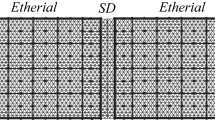Summary.
This paper addresses the numerical approximation of microstructures in crystalline phase transitions without surface energy. It is shown that branching of different variants near interfaces of twinned martensite and austenite phases leads to reduced energies in finite element approximations. Such behavior of minimizing deformations is understood for an extended model that involves surface energies. Moreover, the closely related question of the role of different growth conditions of the employed bulk energy is discussed. By explicit construction of discrete deformations in lowest order finite element spaces we prove upper bounds for the energy and thereby clarify the question of the dependence of the convergence rate upon growth conditions and lamination orders. For first order laminates the estimates are optimal.
Similar content being viewed by others
References
Ball, J.M., James, R.D.: Fine phase mixtures as minimizers of energy. Arch. Rat. Mech. Anal. 100, 13–52 (1987)
Ball, J.M., James, R.D.: Proposed experimental tests of a theory of fine microstructure and the two-well problem. Phil. Trans. R. Soc. Lond. A~338, 389–450 (1992)
Bartels, S.: Numerical analysis of some non-convex variational problems. PhD- Thesis, Universität Kiel, 2001. Available at http://e-diss.uni-kiel.de/math-nat.html
Belgacem, H.B., Conti, S., DeSimone, A., Müller, S.: Rigourous bounds for the Föppl-von Kármán theory of isotropically compressed plates. J. Nonlinear Sci. 10, 661–683 (2000)
Carstensen, C., Plecháč, P.: Numerical solution of the scalar double-well problem allowing microstructure. Math. Comp. 66, 997–1026 (1997)
Carstensen, C., Roubíček, T.: Numerical approximation of young measures in non-convex variational problems. Numer. Math. 84, 395–415 (2000)
Chipot, M., Collins, C.: Numerical approximations in variational problems with potential wells, SIAM J. Numer. Anal. 29, 1002–1019 (1992)
Chipot, M.: The appearance of microstructures in problems with incompatible wells and their numerical approach. Numer. Math. 83, 325–352 (1999)
Chipot, M., Collins, C., Kinderlehrer, D.: Numerical analysis of oscillations in multiple well problems. Numer. Math. 70, 259–282 (1995)
Chipot, M., Müller, S.: Sharp energy estimates for finite element approximations of non-convex problems in: Variations of domain and free-boundary problems in solid mechanics (Paris),~pp. 317–325 (1997)
Ciarlet, P.G.: The Finite Element Method for Elliptic Problems. Amsterdam: North-Holland, 1978
Matthias, G.K., Prohl, A.: A discontinuous finite element method for solving a multi-well problem. SIAM J. Numer. Anal. 37, 246–268 (1999)
Kohn, R.V., Müller, S.: Branching of twins near an austenite/twinned martensite interface. Phil. Mag. 66A, 697–715 (1994)
Kohn, R.V., Müller, S.: Surface energy and microstructure in coherent phase transitions. Comm. Pure Appl. Math. 47, 405–435 (1994)
Kružík, M.: Numerical approach to double well problems. SIAM J. Numer. Anal. 35, 1833–1849 (1998)
Li, B.: Finite element analysis of a class of stress-free martensitic microstructures. Math. Comp., 2002. In press
Li, B., Luskin, M.: Nonconforming Finite element approximation of crystalline microstructure. Math. Comp. 67, 917–946 (1998)
Li, B., Luskin, M.: Theory and computation for the microstructure near the interface between twinned layers and a pure variant of martensite. Mat. Sci. Eng. A, 273–275, 237–240 (1999)
Luskin, M.: Approximation of a laminated microstructure for a rotationally invariant, double well energy density. Numer. Math. 75, 205–221 (1997)
Luskin, M.: On the computation of crystalline microstructure. Acta Numerica, 1996
Müller, S.: Variational models for microstructure and phase transitions. Springer. Lect. Notes Math. 1713, 85–210 (1999)
Pedregal, P.: On the numerical analysis of nonconvex variational problems. Num. Math. 74, 325–336 (1996)
Prohl, A.: An adaptive finite element method for solving a double well problem describing crystalline microstructure. M2AN 33, 781–796 (1999)
Shield, T.W.: Needles in Martensites. www.aem.umn.edu/people/faculty/shield/ needles
Author information
Authors and Affiliations
Corresponding author
Additional information
Mathematics Subject Classification (2000): 65K10, 65M50, 65N30, 73C50, 73S10
Rights and permissions
About this article
Cite this article
Bartels, S., Prohl, A. Multiscale resolution in the computation of crystalline microstructure. Numer. Math. 96, 641–660 (2004). https://doi.org/10.1007/s00211-003-0483-8
Received:
Revised:
Published:
Issue Date:
DOI: https://doi.org/10.1007/s00211-003-0483-8





